
By Bert Ho, Senior Underwater Archaeologist - National Park Service
May 4, 2017
One of the main reasons Midway Atoll was created as a national wildlife refuge is because of the nesting bird populations. As soon as you step foot on Midway, or are downwind of it, you smell the aroma of its most numerous resident: the Laysan albatross. You see the immature fledglings dotting the fields and roads, the mature adults gliding gracefully in the air, and you hear them, constantly. If you take the time and watch them, you realize that while they are graceful in the air, their landings and take-offs are often sputtering, failed attempts, or complete crash landings.
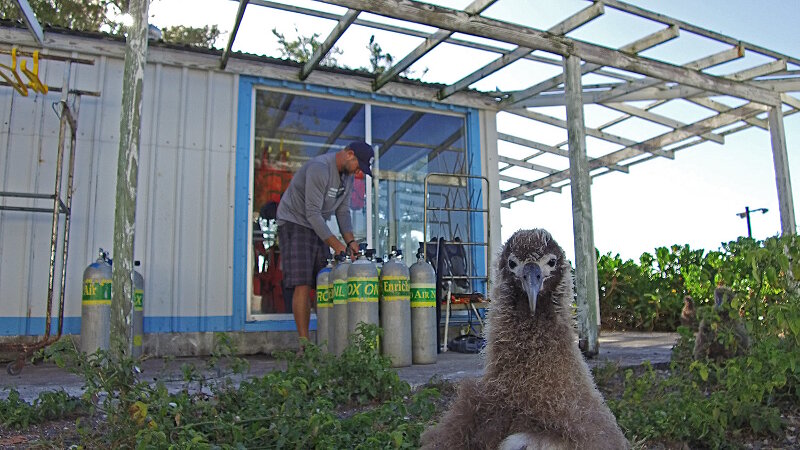
NOAA resource protection specialist Brian Hauk fills scuba tanks for the next day’s dive with a young albatross in the foreground. Image courtesy of Brett Seymour, Exploring the Sunken Heritage of Midway Atoll expedition. Download larger version (jpg, 699 KB).
We did not have any crash landings as our project began its first full day of field work, but we did have some sputterings in trying to get all equipment up and running. With this being an underwater exploration, we are highly reliant on boats and need to be extra vigilant to their operation when working in such a remote location.
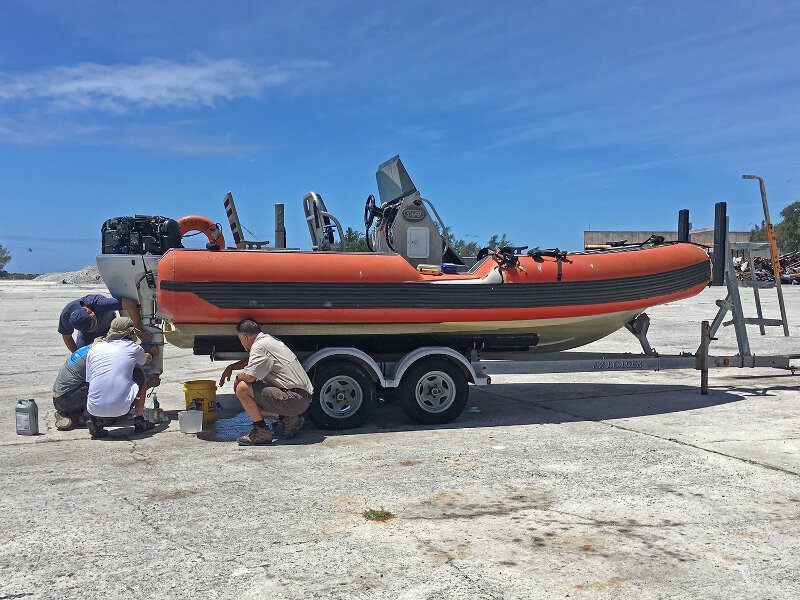
The team readies one of the U.S. Fish and Wildlife Service small boats for operations at Midway Atoll. Image courtesy of Brett Seymour, Exploring the Sunken Heritage of Midway Atoll expedition. Download larger version (jpg, 900 KB).
The U.S. Fish and Wildlife Service partnership in this project includes the use of their vessels permanently housed here at the atoll. Setting up computers, GPS devices, magnetometers, dive gear, safety equipment, and radios all take time on each boat.
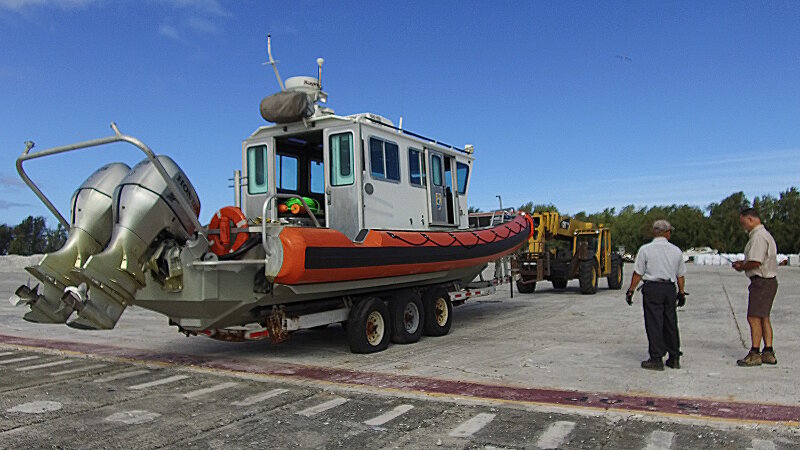
The team getting the boat ready to get in the water for survey at Midway Atoll. Image courtesy of Brett Seymour, Exploring the Sunken Heritage of Midway Atoll expedition. Download larger version (jpg, 637 KB).
Keeping equipment in operational condition here takes a lot of problem solving skills, creativity, and occasionally the ability to salvage, re-use, or re-purpose parts. There are no “West Marines” or “Home Depots” around, just what you can rebuild and often what you can make work again. Luckily, the team on this expedition has a lot of combined experience working on and around boats, and taking on these tasks are just part of the day’s work.
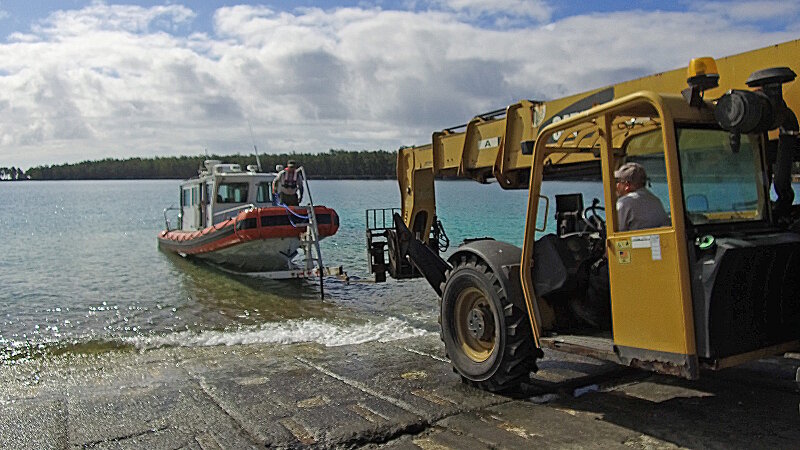
The team launches the boat for remote sensing survey operations at Midway Atoll. Image courtesy of Brett Seymour, Exploring the Sunken Heritage of Midway Atoll expedition. Download larger version (jpg, 715 KB).
As employees of multiple federal agencies engaged in scientific research, there are of course many protocols that must be followed for safety, which includes running risk assessments, filing float plans and dive plans, conducting radio checks throughout the day, and essentially treating any work on the water or on land as serious tasks. While there is a physician’s assistant here at the atoll for medical care, there is no quick or easy way to get anyone to a hospital or access to care for an injury requiring serious medical intervention. In short, you do NOT want to get hurt out here on Midway!
Survey operations with the magnetometer (learn more about surveying with magnetometers) began today with several anomalies, or ferrous objects, detected by the magnetometer in the first completed survey block. These will need visual inspection by diving, which will likely begin once the initial invasive species surveys are completed on the known historic sites discovered previously at Midway Atoll.
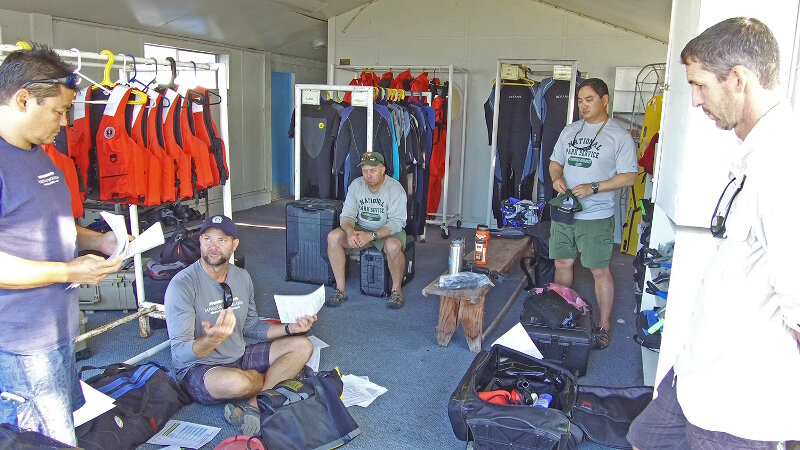
The team discusses safety protocol and the next day’s operations. Image courtesy of Brett Seymour, Exploring the Sunken Heritage of Midway Atoll expedition. Download larger version (jpg, 686 KB).
For the next few days, operations will likely be somewhat similar each day: one survey boat continually collecting magnetometer data; one boat dedicated to diving for invasive species surveys and investigating magnetic anomalies detected. Each night, all data will be processed, and the list of anomalies will grow.
While we did not quite flap our wings, clip a tree branch, and tumble down in a heap of feathers and dust like an albatross did before us today, we did have a few hiccups preventing both teams from taking off today. Eighteen new anomalies were discovered in the first survey block though, and that is something everyone on island is excited about. Stay tuned to see if any of these anomalies are historically significant, or perhaps the planes we are searching for.